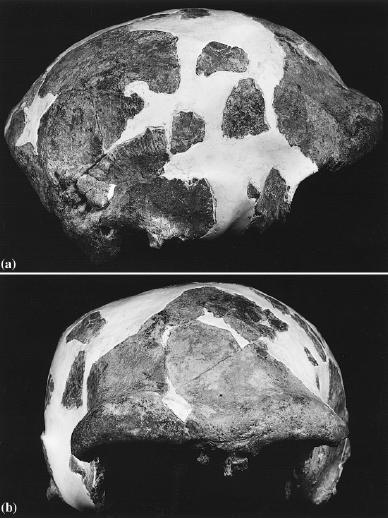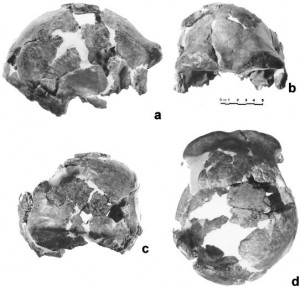May 5, 2011
Another Surprise Fossil Announcement
Hot on the heels of new insights into Paranthropus, now comes news of more fossil hominoid revisions. One form of the Heidelberg Man may not be what it appeared to be.

The previously described species, named from fossil finds found in Italy, Homo cepranensis may turn out to be more of a great-great-great-great (etc.) grandfather than a cousin. The 400,000-year-old fossil was thought to represent a new species of human, Homo cepranensis. But the latest study, however, identifies Ceprano as being an archaic member of Homo heidelbergensis.



As Discovery News notes, this species may have given rise to both Neanderthals and Homo sapiens:
“Considering other fossils that can be lumped together with Ceprano in H. heidelbergensis, we can hypothesize that the ‘Ceprano-morphotype’ was tall, with a strong mandible (jaw) and small teeth,” coauthor Silvana Condemi told Discovery News.
Condemi is the Director of Research at the National Center of Scientific Research (CNRS) in the laboratory of anthropology at the University of Marseille, where she directs the unit of paleoanthropology.
For the study, she and colleagues Aurelien Mounier and Giorgio Manzi compared Ceprano with 42 fossils from Africa and Eurasia ranging from 1.8 million to 12,000 years ago. The scientists also compared Ceprano to 68 modern humans. The sample set is the most extensive ever assembled in relation to the ancient Italian fossil.
In addition to identifying Ceprano as a Heidelberg Man, the analysis found notable similarities with other human-associated fossils from Europe dating to the Middle Pleistocene 781,000 to 126,000 years ago. Connections were also made to early human fossils from Africa. The researchers therefore believe that Homo heidelbergensis was widespread, dispersing throughout Eurasia and Africa beginning around 780,000 years ago.
Good weather may have permitted Heidelberg Man’s worldly lifestyle.
“We can hypothesize that particular environmental conditions during the Middle Pleistocene may have favored the expansion of H. heidelbergensis and contacts between populations,” explained Condemi, who is also the co-editor of the new book Continuity and Discontinuity in the Peopling of Europe (Springer, 2011). “The gene flow was never completely stopped between Old World populations.”
Paleontologist Chris Stringer of the Natural History Museum, London, told Discovery News that he agrees with most of the new study’s conclusions.
“I have long argued that Homo heidelbergensis represented our common ancestor with the Neanderthals about 400,000 years ago, and the Ceprano fossil, with its newly-determined late date, is well-situated chronologically to be part of this common ancestral group,” Stringer said.
“However, it is quite a primitive specimen in several respects and therefore it may be that, like some other samples of heidelbergensis in Africa and Europe, it does not represent the actual last ancestral population,” Stringer added.
“In my view, we still do not know where that particular population existed,” he explained, “and it may even have lived in a place from which we have very little evidence at present, such as western Asia.”
Ian Tattersall, curator of anthropology at the American Museum of Natural History, told Discovery News that he agrees Ceprano has been “appropriately assigned to the cosmopolitan species Homo heidelbergensis. But in Europe this species is contemporaneous with the lineage leading to Homo neanderthalensis.”
If Homo heidelbergensis did arrive before modern humans, “it must thus have been via an earlier, presumably African, representative of the species,” Tattersall explained.
While many eyes are on Heidelberg Man as being the likely common ancestor to Neanderthals and our species, the jury is still out as to where that pivotal evolution took place.
Anthropologist Eric Delson of Lehman College, The City University of New York, thinks the new study is “very interesting and takes a good approach,” but he believes additional research is needed to elucidate exactly when, where and how Neanderthals and modern humans originated.
===

The 1940s’ view of Heidelberg Man is long overdue for a revision.
Could some answers for cryptozoologically-inclined thinking in hominology exist in this tangled weave of relationships, especially if any survivals of Heidelberg hominoids and Neandertals are in the mix?
 About Loren Coleman
About Loren Coleman
Loren Coleman is one of the world’s leading cryptozoologists, some say “the” leading living cryptozoologist. Certainly, he is acknowledged as the current living American researcher and writer who has most popularized cryptozoology in the late 20th and early 21st centuries.
Starting his fieldwork and investigations in 1960, after traveling and trekking extensively in pursuit of cryptozoological mysteries, Coleman began writing to share his experiences in 1969. An honorary member of Ivan T. Sanderson’s Society for the Investigation of the Unexplained in the 1970s, Coleman has been bestowed with similar honorary memberships of the North Idaho College Cryptozoology Club in 1983, and in subsequent years, that of the British Columbia Scientific Cryptozoology Club, CryptoSafari International, and other international organizations. He was also a Life Member and Benefactor of the International Society of Cryptozoology (now-defunct).
Loren Coleman’s daily blog, as a member of the Cryptomundo Team, served as an ongoing avenue of communication for the ever-growing body of cryptozoo news from 2005 through 2013. He returned as an infrequent contributor beginning Halloween week of 2015.
Coleman is the founder in 2003, and current director of the International Cryptozoology Museum in Portland, Maine.
Email • Facebook • Twitter •
Filed under Breaking News, Cryptomundo Exclusive, CryptoZoo News, Cryptozoology, Forensic Science, Fossil Finds





